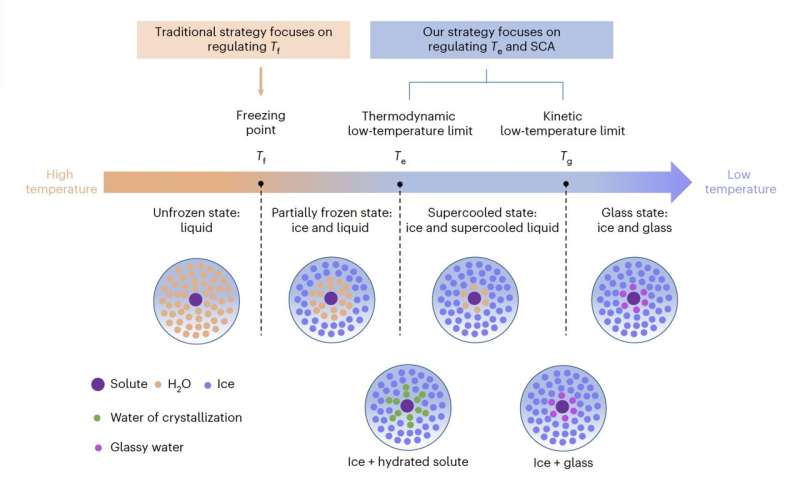May 31, 2024 feature
This article has been reviewed according to Science X's editorial process and policies. Editors have highlighted the following attributes while ensuring the content's credibility:
fact-checked
peer-reviewed publication
trusted source
proofread
A strategy to design anti-freezing electrolytes for batteries that can operate in extremely cold environments

Battery technologies that can reliably operate at very low temperatures could be highly valuable for a wide range of applications. These batteries could, for instance, power devices, vehicles, and robotic systems in outer space, deep under the sea, and in other extreme environments.
To safely and effectively operate in these environments, batteries should have components that do not freeze or adversely react to significant drops in temperature. One proposed solution is the design of rechargeable aqueous batteries containing so-called anti-freezing electrolytes.
Researchers at the Chinese Academy of Sciences and other institutes in China recently devised a new strategy to design anti-freezing electrolytes for aqueous batteries. This strategy, outlined in a paper published in Nature Energy, focuses on two specific temperature-related factors, which have so far not been the primary focus of anti-freezing electrolyte design.
"Designing anti-freezing electrolytes through choosing suitable H2O–solute systems is crucial for low-temperature aqueous batteries (LTABs)," Liwei Jiang, Shuai Han, and their colleagues wrote in their paper.
"However, the lack of an effective guideline for choosing H2O–solute systems based on decisive temperature-limiting factors hinders the development of LTABs. Here we identified two decisive factors: thermodynamic eutectic temperature (Te) and kinetic glass-transition temperature (Tg), with Tg being applicable for LTABs only when H2O–solute systems have strong super-cooling ability."
Most previous works aimed at designing anti-freezing electrolytes focused on regulating the so-called freezing point (Tf) which is essentially the exact point at which a liquid freezes and becomes solid. This could be achieved using a variety of different approaches.
Nonetheless, Tf might not be the most crucial factor limiting the operation of batteries at low temperatures. In fact, some electrolytes allow batteries to operate at low temperatures even when partially frozen, thus below their Tf point.
In their paper, therefore, Jiang, Han and their colleagues focus on two other temperature-related factors, namely Te and Tg, The first of these is the lowest temperature at which a liquid solution remains stable at a given pressure, while the latter is the temperature at which molecular mobility starts to occur and below which this mobility becomes frozen, prompting a transition to a rigid and glassy phase.
"We proposed a general strategy wherein low-Te and strong-super-cooling ability electrolytes can be realized by creating multiple-solute systems via introducing assisted salts with high ionic-potential cations (for example, Al3+, Ca2+) or cosolvents with high donor numbers (for example, ethylene glycol)," the researchers wrote.
"As a demonstration in Na-based systems, we designed electrolytes with ultralow Te (−53.5 to −72.6 oC) and Tg (−86.1 to −117.1 oC), showcasing battery performances including 80 Wh kg−1 and 5,000 cycles at 25 oC, and 12.5 Wh kg−1 at −85 oC."
In their paper, the researchers proved that a detailed guideline that can be used to design anti-freezing electrolytes for aqueous batteries meant to operate at low temperatures. In the future, this guideline could prove useful to other research groups, potentially contributing to the development of better performing battery solutions for technologies designed to be deployed in space, in the deep sea and in other settings characterized by extremely low temperatures.
More information: Liwei Jiang et al, Rational design of anti-freezing electrolytes for extremely low-temperature aqueous batteries, Nature Energy (2024). DOI: 10.1038/s41560-024-01527-5
© 2024 Science X Network


















